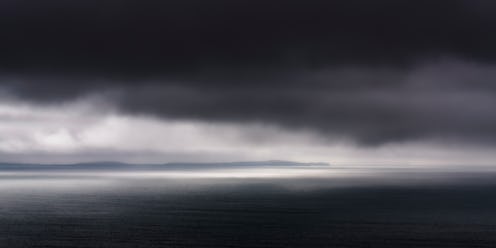Life
Scientists Might Have Solved The Bermuda Triangle

After dozens of unexplained disappearances, has the mystery of the Bermuda Triangle been solved? Some meteorologists believe so. Normally, realistic explanations for mysterious phenomena tend to suck all the joy out of conspiracy theories, but in this case, my fellow connoisseurs of creepiness have nothing to worry about. While the meteorological theory isn't quite as fun as the mythology surrounding the Bermuda Triangle, it's still pretty darn weird, and it has the bonus of being mostly plausible.
The Bermuda Triangle, sometimes known as the Devil's Triangle, has loomed large in North American folklore for decades. The exact boundaries are vague, but it's generally agreed to exist in the area between Florida, Puerto Rico, and Bermuda. Although it might appear ordinary on a map, this particular patch of sea is said to be incredibly dangerous: Ships and aircraft that enter the Triangle tend to vanish without a trace. (At least, that's how the story goes.) The area's mysterious reputation began in 1945, when five torpedo bombers carrying fourteen men, known as Flight 19, disappeared during a Navy training mission. During the ensuing search for the squadron, one of the search planes vanished as well, and what had previously been an unremarkable area became the Bermuda Triangle.
Well, the name wasn't coined until 1964, but you get the idea. In the intervening decades, the Triangle has been blamed for dozens of other mysterious events, including the disappearances of the USS Cyclops and the SS Marine Sulphur Queen.
Some explanations for these disappearances read like an episode of the Twilight Zone. According to meteorologists recently featured on the Science Channel's What on Earth? , though, they can be chalked up to a far more worldly explanation: bad weather.
But not just regular bad weather. Meteorologist Dr. Randy Cerveny explains that satellite images of the western side of the Triangle show strange, hexagonal cloud formations. "These types of hexagonal shapes over the ocean are, in essence, 'air bombs,'" he tells What on Earth?. "They're formed by what are called microbursts." He goes on to explain that these sudden air currents can reach up to 170 miles per hour, and when they shoot down into the ocean from the bottom of a cloud, they can create "massive" waves.
To put this in perspective, a hurricane is considered Category Five when its winds reach 157 mph. That kind of force can destroy a home — or knock a plane out of the sky.
Most scientists agree that there's some sort of environmental explanation for the Triangle's hidden dangers. The National Ocean Service notes on its website that the majority of tropical storms and hurricanes in the Atlantic pass through the area, and the Gulf Stream can create "rapid, sometimes violent, changes in weather." Before meteorological instruments became as finely-tuned as they are today, these unpredictable shifts could prove treacherous. Another popular theory is that the Triangle's magnetic field points to "true" north rather than magnetic north, which could cause voyages to become lost.
Then there are the supernatural explanations: The lost city of Atlantis radiates metaphysical energy from the bottom of the sea that interferes with navigational instruments, or that the disappearances are caused by aliens. You had to know that one was coming.
No matter what theory floats (or sinks) your boat, it's fascinating stuff. Check out the clip explaining the cloud formation theory here.
Images: Westend61/Westend61/Getty Images, Wikimedia Commons (2)